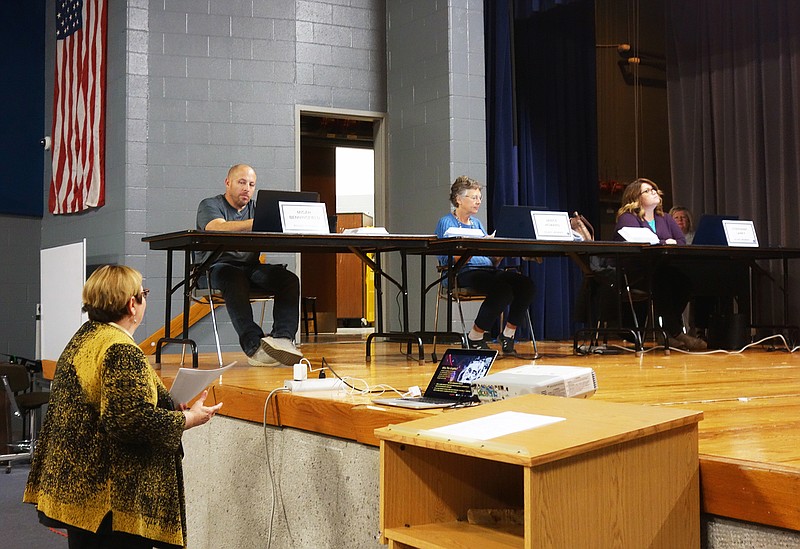MOKANE - Teachers at South Callaway R-2 are hard at work helping students recover skills after COVID-19 disrupted classrooms.
But to do that effectively, they must know how far each student has fallen behind and where the gaps in their learning lie. During Wednesday's board of education meeting, Director of Curriculum and Instruction Mary VanOrden updated board members on how instructors are assessing learning loss among students.
VanOrden cautioned that the assessment measures are imperfect.
"What a student absorbs is often inaccurately measured," she said. "We're called upon to do so anyway, in order to judge progress."
Like other area school districts, South Callaway abruptly transitioned to virtual learning in March of this year. Though most students returned to in-seat instruction in August, students in all district schools went home again Oct. 22-30, and South Callaway High School students are learning from home this week.
"It's been a tough year for businesses, parents and teachers," South Callaway superintendent Kevin Hillman said. "There's - I'm going to use use the word - exhaustion."
Instructors expect students to forget some material every summer, and anticipated learning disruptions would result in additional loss of learning. To assess how much, they administered an assessment known as "I-Ready" to most students; English 2 students used a different assessment called MO LEAP. Both measure knowledge of content the students should have learned the previous year. The district gives I-Ready assessments to students every year.
"But we gave these quite a bit earlier in the year than we have in the past," VanOrden said.
Then, instructors compared results to students' past performance. They compared results from the beginning of the 2020-21 school year to results from the beginning and middle of the 2019-20 school year.
The district found that across grade levels, students had a 24 percent loss of learning in reading skills and a 29 percent loss in math skills between the middle of the 2019-20 school year and August. In terms of readiness, 3 percent of students were less ready for the next grade level of reading than they were entering the previous year, and 6 percent for math.
"A 24 percent loss of learning isn't as bad as it sounds," Hillman said.
It doesn't mean students have forgotten nearly a quarter of everything they've ever learned - rather that a greater percentage of students tested below their grade level in terms of skills this year compared to last year.
VanOrden said early signs indicate South Callaway students have fared better than those in many other districts. A friend of hers who works in a district in southern Boone County said while they haven't finished processing their assessment results, they're looking at at least 40 percent loss of learning.
And, she added, some students came in more ready for the next level of reading this year than they did last year, which "surprised us," she said.
VanOrden said these losses don't mean South Callaway will be in trouble with the Department of Elementary and Secondary Education when standardized testing rolls around.
"The state assessment will change based on DESE's assessment of loss of learning," she said.
Catching up
Teachers are using a variety of methods to help students recover lost skills and review material, depending on grade level and the individual student's needs.
Teachers haven't exhaustively reviewed the previous year's material before going on to new skills, VanOrden said. Instead, reviews take place concurrently with instruction in new material.
"They fill in gaps as they come along," she explained.
Schools have also expanded intervention time.
"We've extended our literacy block to accommodate it," elementary principal Corey Pontius said.
The middle school has a special resource period for students who failed a class last year. Teachers are also focusing attention on students who are one grade level behind on skills, and they're catching up fast, VanOrden said.
But challenges remain, and are compounded each time students switch back to virtual learning - especially for students who don't have a reliable internet connection at home, have difficult home lives or need special learning accommodations.
"When they go home, we can't level the playing field," Early Childhood principal Leah Dunlap said.
In some ways, despite the extra prep, transitions to learning from home have been more challenging this fall than last spring, Dunlap said. In the spring, many parents were also working from home while their children learned. Now they're back at work, and students are in childcare or staying with family members during the day. That means many students are completing the majority of their daily learning in the evening, after they've already used up much of their focus and energy.
"We know that kids in kindergarten through second grade learn best before noon," she said.
Still, teachers are doing their best, and constantly adapting their instructional techniques and communication to best suit students' needs. They'll continue to gather data and reassess progress throughout the school year, the principals said.
"I'm so proud of our teachers and our families," Pontius said.

